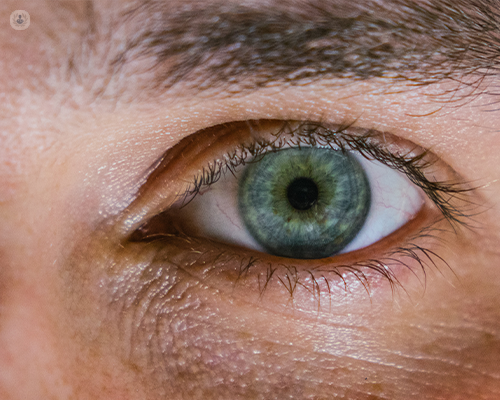Choosing the best tear trough filler treatment for you
Written in association with:Tear trough fillers are being considered by more and more people nowadays. It goes without saying how mask wearing, due to Coronavirus, has contributed to the eyes being noticed more than ever. Top Doctors speaks to consultant ophthalmic and oculoplastic surgeon Miss Elizabeth Hawkes about how to stay best-informed about this popular procedure.

Who is a good candidate for tear trough fillers?
Firstly, a tear trough is the junction between the lower eyelid and cheek. People that have a tear trough with volume loss and the appearance of dark circles are candidates for tear trough fillers, which is an injectable treatment to add more volume under the eyes.
Which is best, dermal fillers or Botulinum toxin?
Both can enhance the appearance of the eyes but they work in different ways.
To begin, it's good to describe what a filler is and what botulinum toxin is. A dermal filler is based on hyaluronic acid, which is a natural substance broken down by the body. It supports and adds volume which allows for a smoother, hydrated result that is plumper.
Botulinum toxin is also an injectable and smoothens the appearance of fine lines by neuromodulation. Neuromodulation weakens muscle contraction by blocking the signal between the nerve and the muscle. Over time, it results in softening the appearance of the lines that are caused by repetitive muscle contraction.
While they can be used separately, dermal fillers and botulinum toxin can also be used in combination to rejuvenate the appearance of the tear trough area and restore the natural beauty of the eye.
At what age is it ok to have fillers?
Importantly, it’s now become illegal to administer cosmetic fillers or botulinum toxin to under 18s in the UK under new legislation passed this year (2021).
What I would say is that a suitable candidate is when someone starts to first show the signs of a tear trough deformity or volume loss. It usually occurs around the age of 30 upwards, there is no specific age. Dermal fillers are used to add volume to other parts of the face that deflate with ages, particularly the cheeks, lips and chin. It's definitely something that shouldn't be taken lightly and I would advise people interested in tear trough or facial dermal fillers to speak to a doctor about the best specific treatment.
Are under-eye fillers safe?
Yes, if the procedure is performed by a qualified person. It's complex and need to be done in experienced, capable hands. It's a very safe process but if the practitioner doesn't know the correct type of filler, anatomy or select the appropriate patient it can result in negative appearance.
Dermal fillers anywhere on the face carry a small risk of vascular occlusion (blood vessel). If your skin is affected, you might have skin loss or wounds. If your eye is affected, you might lose your eyesight or go blind. It needs to be treated immediately and can be reversed with an enzyme available to the dermal filler. This is why it needs to be done with a qualified practitioner, luckily the tear trough is a low-risk area.
When might surgery be a better option?
As mentioned earlier, the lower eyelid's ageing signs, such as orbital fat prolapse, eyelid laxity, deep tear trough alongside excess skin, can lead to seeking a consultation with an oculoplastic surgeon. Surgery is a more permanent solution called lower eyelid blepharoplasty which uses fat repositioning. Orbital fat from the lower lid is used to fill the tear trough grooves.
Tear trough fillers are required every 18 months and it can create problems in the long term if people overload with fillers. Surgery can be a long-term option.
People need to keep in mind that:
- Their face will naturally change and age over time
- To use a qualified practitioner
- A thorough assessment will decide if surgery or non-surgical procedures will have a better chance of success.
Do you have any further advice?
There has been a huge increase in demand in tear trough fillers. With Covid-19 and mask wearing, eyes have become more of a focus and people's eyes are now on show. Plus, eyes are related to fatigue and when people say 'you look tired', they are usually looking at them.
Considering this, there are many vulnerable people who may suffer with anxiety where they may be seeing things in the mirror that aren’t really there. It's important to reiterate that people looking for tear trough fillers should see a qualified doctor with good ethics to be able to evaluate whether treatment is required or not. They need to be a qualified medical professional certified to do injectable procedures and from a surgical point of view, qualified in oculoplastic surgery and the blepharoplasty procedure, too.
Are you considering tear trough fillers? Miss Elizabeth Hawkes offers extensive guidance and expertise in this procedure. Visit her Top Doctors profile here.


